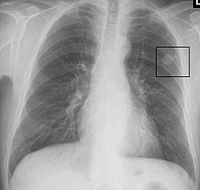
Photo from wikipedia
PURPOSE We aimed to evaluate and compare the growth patterns among pathological types of inde- terminate subsolid nodules in patients without a history of cancer as observed on computed tomography… Click to show full abstract
PURPOSE We aimed to evaluate and compare the growth patterns among pathological types of inde- terminate subsolid nodules in patients without a history of cancer as observed on computed tomography (CT). METHODS This retrospective study included 77 consecutive patients with 80 indeterminate subsolid nod- ules on unenhanced thin-section CT. Subsolid nodules were classified into 2 growth pattern groups based on volume: growth (n = 35) and non-growth (n = 42). According to the pathologi- cal diagnosis, subsolid nodules were further subdivided into 3 groups: adenocarcinoma in situ (growth, n = 8 vs. non-growth, n = 22), minimally invasive adenocarcinoma (n = 14 vs. n = 15), and invasive adenocarcinoma (n=13 vs. n=5). Kaplan-Meier and Cox proportional hazards regres- sion analyses were performed to identify the risk factors for subsolid nodules growth. The CT findings of the 35 subsolid nodules in the growth group were compared among the 3 pathologi- cal groups. RESULTS In the growth group, the overall mean volume doubling time and mass doubling time (MDT) were 811.5 days and 616.5 days, respectively. Patient's age (odds ratio=1.041, P=.045) and CT subtype of non-solid nodule and part-solid nodule (odds ratio=3.430, P=.002) could predict subsolid nodule growth. The baseline volume, mass, and mean CT value were larger in the inva- sive adenocarcinoma group than in the adenocarcinoma in situ group (all P < .01). The shortest volume doubling time was observed in the invasive adenocarcinoma group, followed by the minimally invasive adenocarcinoma group and the adenocarcinoma in situ group. A shorter mass doubling time was observed in the minimally invasive adenocarcinoma group than in the adenocarcinoma in situ group (all P < .02). CONCLUSION As age increases, the risk of pulmonary subsolid nodule growth increases by 4% each year, and part-solid nodules have a 3 times higher risk of growth compared to non-solid nodules in patients with no history of cancer. Subsolid nodules with more aggressive pathological charac- teristics grow at a faster rate.
Journal Title: Diagnostic and interventional radiology
Year Published: 2022
Link to full text (if available)
Share on Social Media: Sign Up to like & get
recommendations!